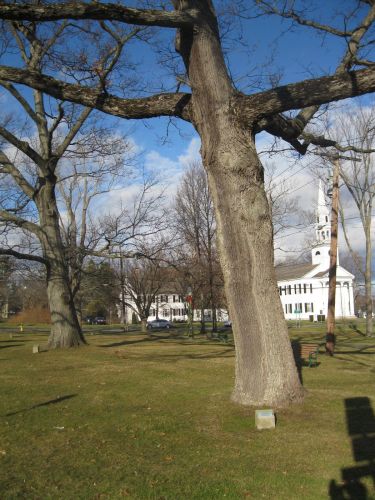By Peter Vermilyea
The first Arbor Day was held on April 10, 1872, and became an international event 11 years later when Birdsley Northrup of Kent, Connecticut, introduced the concept to Japan. However, Theodore Roosevelt’s ascendency to the presidency in 1901 and his emphasis on conservation issues sparked a nationwide surge of interest in Arbor Day.
In 1902 the Mary Floyd Tallmadge Chapter of the Daughters of the American Revolution celebrated the first Arbor Day of Roosevelt’s presidency by planting a tree on the Litchfield Green to commemorate the services of the town’s Revolutionary War soldiers.

A small marker stands at the southeast corner of the eastern section of the Litchfield Green – Peter Vermilyea
Soldiers Pledge to Battle Tyranny
In all, 507 men from Litchfield served the Patriot cause between 1775 and 1783. The first to serve were the men of the company led by David Welch of Milton, who were called up soon after news of Lexington and Concord arrived. A second company enlisted in January 1776 to serve for the defense of New York City. They drafted a contract specifying the terms of their service under Major General Charles Lee, stating that they were convinced of “the Necessity of a body of Forces to defend against certain Wicked Purposes formed by the instruments of Ministerial Tyranny.” They specified, however, that they would not serve for more than 8 weeks and stated that General Lee had “given his Word and Honor” to uphold these terms.
Entire Garrison Captured by British
In November 1776 another company of Litchfield men under Captain Bezaleel Beebe set off for New York. Thirty-six handpicked men of the company under Captain Beebe were sent to reinforce the American garrison at Fort Washington (today the Manhattan end of the George Washington Bridge). The men marched into a trap and were forced to surrender with the entire 2,600-man garrison of the fort. Although the men were exchanged about a month later, only 11 of these men made it home to Litchfield.
In March 1777 a new call for troops went out, and Litchfield was tasked with enlisting 92 of its men. The town voted to pay 12 pounds per year to each soldier and to supply “necessaries” to each soldier’s family. A final call for troops reached town in 1781, and a “selective draft” took place, in which the town was divided into three classes and each class was expected to raise a certain number of men.
In addition to those men who were killed and wounded in battle, 20 Litchfield men died while on the dreaded British prison ships.
Today, a small stone marker stands at the foot of the tree dedicated to these soldiers. Its faded inscription reads:
Planted in Memory of
Litchfield’s Revolutionary Soldiers
by the
Mary Floyd Tallmadge Chapter
DAR
Arbor Day 1902
Peter Vermilyea, who teaches history at Housatonic Valley Regional High School in Falls Village, Connecticut, and at Western Connecticut State University, maintains the Hidden in Plain Sight blog and is the author of Hidden History of Litchfield County (History Press, 2014).
Note: ConnecticutHistory.org does not edit content originally published on another platform and therefore does not update any instances of outdated content or language.








